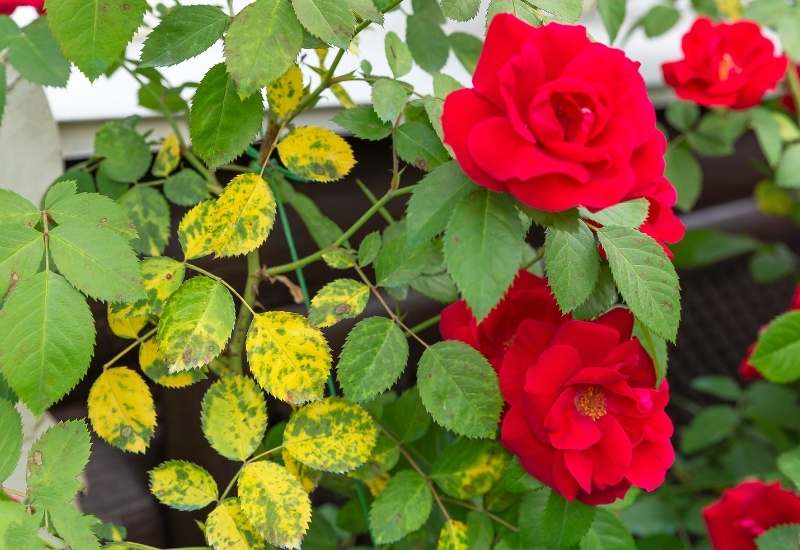
A staple of many home gardens, roses are known for their beautiful flowers but also for their dense foliage.
Understandably, it’s pretty frustrating to see the typically dark green leaves of your rose bush begin to yellow or brown and take away from the overall aesthetic of the plant, and unfortunately there’s no straight answer or turnkey solution to it.
Like most troubleshooting in the garden, the cause for yellowing rose leaves needs to be isolated through the process of elimination.
If it is almost winter and the temperature is cooling down, it is likely natural causes that are turning the leaves of your rose yellow as the plant becomes dormant.
This is normal and the leaves of some varieties such as Rugosa roses actually develop a very striking yellow color that is very aesthetic.
But if it is any other time of the year when they should be a rich, dark green then there is an imbalance your plant is alerting you to.
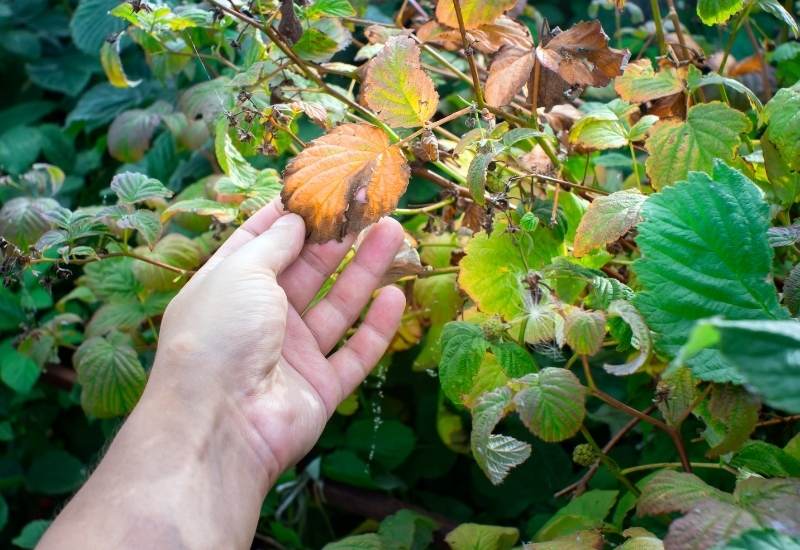
The main causes for yellowing rose leaves are overwatering, underwatering, overfertilization, lack of soil nutrients, overheating, lack of light, or it could be a pest or disease related issue.
Keep reading to take a deep dive into each of these seven causes, as they are not as simple as they may seem.
Specific solutions will be discussed that offer helpful care tips you might not have known even if they turn out not to be the issue.
You will certainly leave with a more thorough understanding of your plant and be able to prevent yellowing in the future!
7 Common Causes For Yellowing Leaves On Rose Bush
When rose leaves turn yellow and drop off, your plants are sending out a cry for help.
Here are seven possible reasons why rose leaves turn yellow and what to do about each one:
1: Overwatering Can Lead To Rose Leaves Yellowing
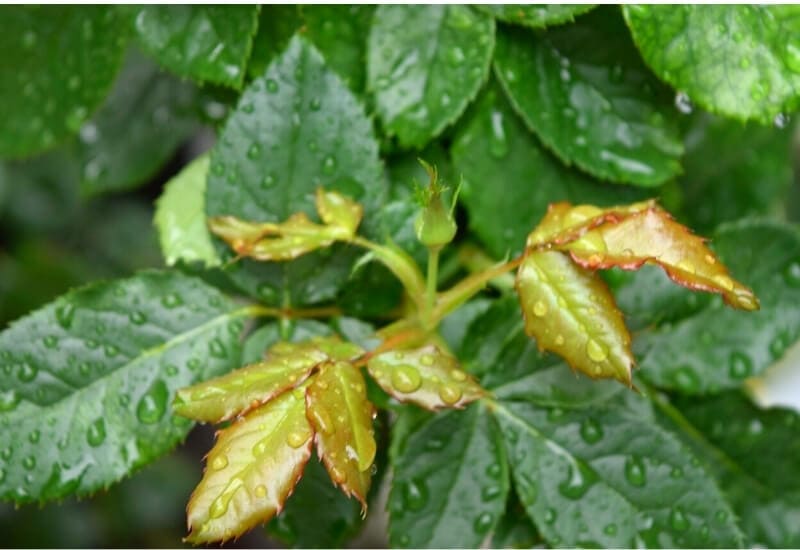
Rose bushes require soil that is evenly moist down to about 10 inches or 25cm, but like most plants they do not enjoy waterlogged soil. The roots require soil that has some air in it so that they can still breathe, otherwise they are not able to get enough oxygen which is what ultimately causes yellowing leaves on rose plants.
If the roots remain boggy they can begin to rot and the plant will eventually die. Note that if the yellowing started in the veins and then spread to the rest of the leaf, oxygen deficiency is likely the cause and the roots might be waterlogged.
There are a few reasons that your roses may be getting too much water, and the obvious one is that you just might be watering your roses too frequently.
Or maybe the area your roses are planted in is low-lying relative to the rest of your garden, meaning surrounding water drains into that spot.
The soil they are planted in may have particularly poor drainage, such as clay-based soils. Or if your roses are planted in pots or containers, they may not have sufficient drainage holes or the holes could be blocked.
What to do about it:
Watering schedules are very dependent on your climate but usually a good, deep soak around once a week during the growing season is sufficient for most rose varieties.
To determine if the soil is too dry use a moisture meter or stick your finger all the way in the soil and if it is still moist then it’s fine.
If they are in a low, boggy area of the garden then dig trenches to redirect water or transplant them to a different spot or into a raised bed.
If the soil is clay based you can still use it as long as you amend it with organic materials, like coconut coir or orchard bark and you could add perlite or pumice as these all improve drainage.
If they are in containers with no drainage simply repot them or install drainage holes and place them slightly elevated from the ground.
2: It Isn’t Getting Enough Water (Drought Stress)
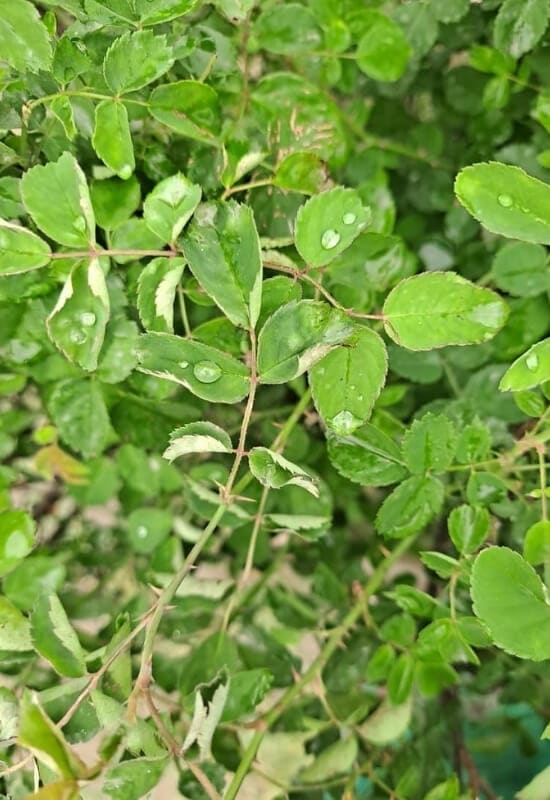
As mentioned above, roses thrive in moist soil down to about 8-12 inches. If the soil dries out then the root system is simply not getting what water it needs to survive and the leaves of your rose bush will turn yellow and fall off.
Again the cause could be as simple as not watering frequently enough or using an inefficient watering technique.
It could also be due to the soil having poor water retention, common in sandy soils, or the type of container the roses are planted in.
If the position of planting is so that the sun directly hits the base of the plant, then it is likely the water is quickly evaporating before it gets a chance to soak in and reach the roots.
What to do about it:
Mulch is an effective way to combat a number of the above causes, as it holds water around the base of the plant, decreasing evaporation.
It also amends the soil with organic matter so if your soil is very sandy it will gradually improve with regular mulching. A one inch layer of compost is a nutritious and effective mulch, but wood chips are also frequently used with rose bushes.
Using a drip hose or soaker hose is an effective way to ensure the plant receives a steady supply of water, as sprinklers and other overhead watering systems often lose a lot of water to evaporation, especially in hot climates.
If your rose is planted in a terracotta or dark coloured pot, this could also dry out the soil as the sun heats up the container. Consider planting in a different, lighter coloured container or in the ground
3: Too Much Fertilizer Can Also Cause Yellowing On Rose Bush
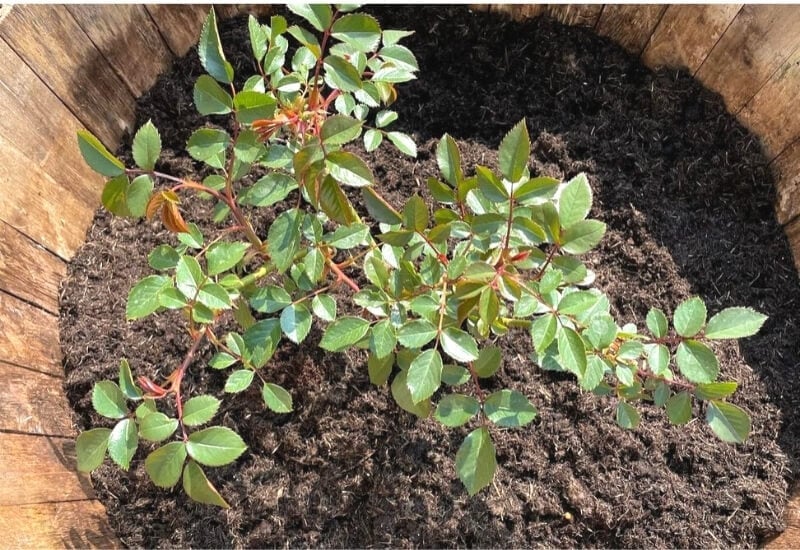
Excess amounts or too high concentrations of fertilizers can both create a yellowing and burnt complexion on rose leaves.
Synthetic fertilizers have high levels of salt that build up underground and damage the roots ability to suck up water.
If you are using fertilizers elsewhere in the garden they could also be getting washed into your rose bush during heavy rainfalls and creating an excess.
What to do about it:
Fertilizing needs are very plant specific and generally require quite a bit of tinkering to get right, but remember it is always best to under-fertilize and gradually add more than to over-fertilize.
Try cutting back and using a natural, slow-release fertilizer that is specific for rose bushes, or a well balanced compost, and be aware of the fertilizers you are using elsewhere in your garden and if they are water-soluble or not.
Prune back the affected leaves and give your rose bush a big drink of water and it should recover in no time.
4: Its Soil Nutrients Are Off
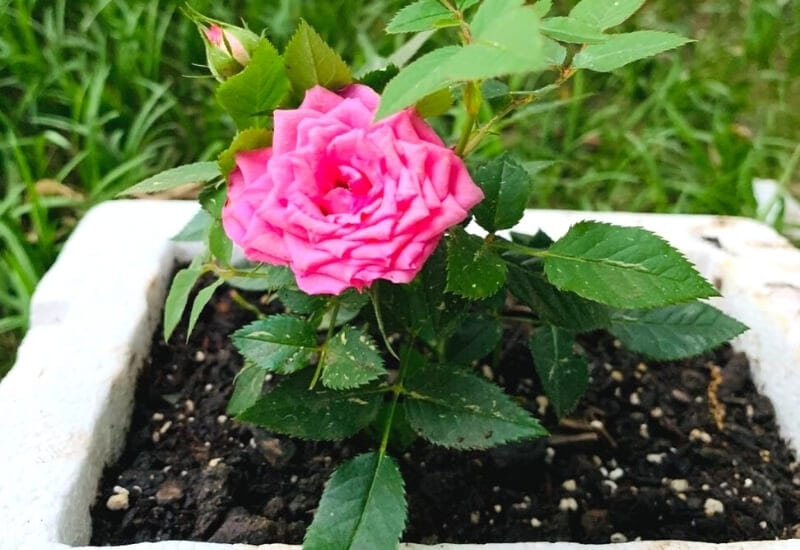
Just as too much fertilizer can cause yellowing leaves on rose, poor soil with insufficient nutrients can also create this effect. The common culprit is nitrogen, which is essential for roses to soak up energy from the sun, but magnesium and iron are also common deficiencies.
Soil pH that is too high (called alkaline) is also unfavourable for roses, as it limits the availability of nutrients that roses like through something called chlorosis. If the leaves of your plant are turning yellow but the main veins are still green,
it is likely that chlorosis is the issue and as a result your roses are iron deficient. A pH etween 6-7 is ideal for roses to thrive and be able to absorb what they need from the soil.
What to do about it:
Figuring out your soil’s nutrients and pH can be done with testing kits or soil gauges, which are inexpensive and can tell you specifically which nutrients are too high or too low, allowing you to rule out a few causes at once.
If low nutrients are the issue then you can amend as needed with specific fertilizers or compost, but if pH is the issue it might be a good idea to transplant it into a pot or a different spot.
You can change soil pH by adding things like cooled ash from a wood-burning fireplace, but it is risky and inconsistent as you may affect the pH more than intended.
If a test tells you that the pH is over 7 then create your own slightly acidic soil mix- ensuring good drainage while you’re at it- and transplant your rose bush into a raised bed or large pot.
5: Overheating Can Also Turn Rose Leaves Yellow
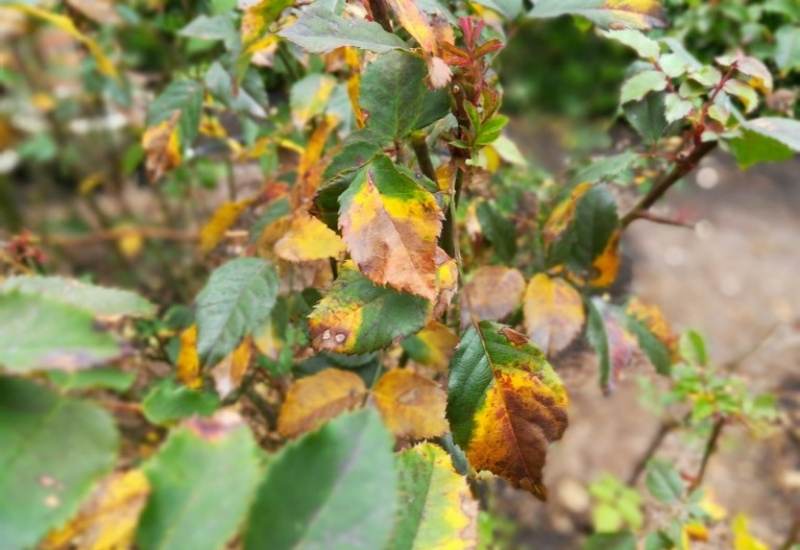
If your rose plant is overheating it will begin to stress and as a result begin to yellow and drop its leaves. This could be due to a heat wave in your area that is a shock to the system, or it could be from water pooling at the base of the plant that reflects sunlight onto lower leaves.
Very dark mulch can also retain heat and have the same effect on lower leaves, and if you are noticing lower leaf yellowing it is likely that the cause is overheating or too little light on the lower leaves (see below).
What to do about it:
Switch your mulch to a lighter color that retains less heat, such as straw or shredded cedar bark.
Make sure you are not overwatering, and after you soak your rose bush check to see that the water is being absorbed by the soil and not pooling above ground around the stem.
If extreme heat persists, introduce an object that provides shade for a few extra hours of the day or move to a slightly cooler and partially shaded area on your property.
6: Rose Leaves Are Not Getting The Enough Sunlight They Need
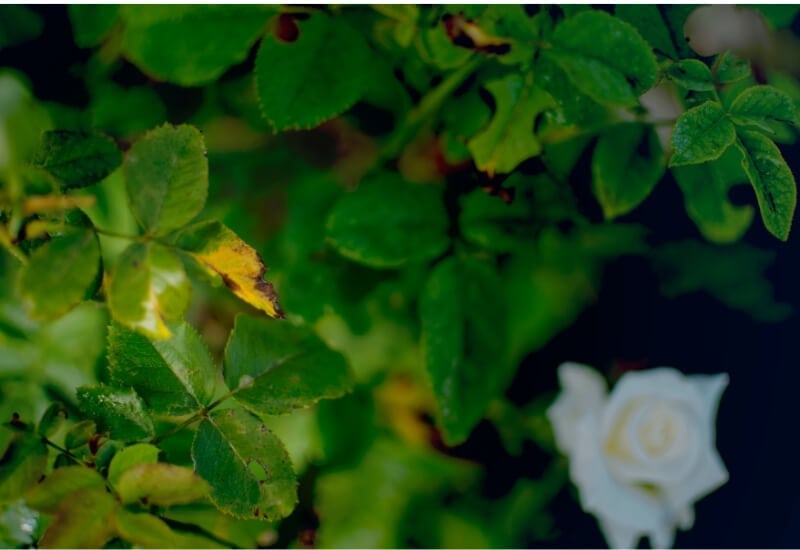
Like overheating, insufficient light usually affects the lower leaves because the upper leaves have become so bushy that they begin to shade the rest of the plant.
However if your plant is in an entirely shaded area and not getting enough sunlight, leaves could yellow everywhere. Roses need at least 6 hours of sunlight per day and should not be in a fully shaded spot.
What to do about it:
Prune back upper branches to let the lower leaves receive sunlight as well. Prune back surrounding plants as needed to open up the area to more sunlight.
If your rose is in a very or fully shade area that cannot be pruned back, transplant it to a different spot as it will never thrive or fully flower in constant shade.
7: Invading Pests or Diseases
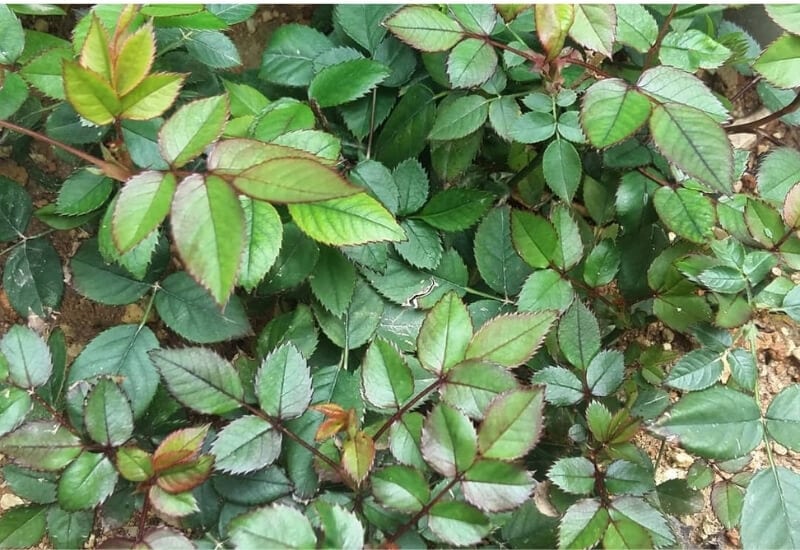
If your rose leaves are turning yellow and even black and brown, they may have the fungal disease Black Spot. Do not despair as it is quite common and treatable if diagnosed early.
If you see signs of insects, then spider mites or rose leaf hoppers may be the culprits. Spider mites cause some mild yellowing and there are usually small webs around the stems.
Rose leaf hoppers cause similar discoloration, and the impact is usually aesthetic more than anything else.
What to do about it:
Black Spot can be treated by pruning back affected leaves with a sterilized tool and burning them. If you put them in your compost pile they can spread the fungus to other plants in the garden.
Use a homemade fungicide with 4 teaspoons baking soda to 1 gallon of water and lightly apply to the leaves to prevent further spread.
Make sure the roses have good airflow between the plants and when watering try to water at the base of the plant to reduce the amount of moisture building up on the leaves.
Spider mites and rose leaf hoppers will not like the applied fungicide, but as an extra precaution you can apply a natural insecticide such as neem oil in small amounts on the affected areas and wherever you see signs of their presence.
Key Things to Remember
Transplanting should be a last resort after having tried other solutions, as digging up any plant and disrupting its root system is always going to be risky and have some adverse effects.
When experimenting with new fertilizers and nutrient additions, give the rose plant at least a couple of weeks to adjust before making your diagnosis, and carefully monitor any new effects.
A healthy rose bush will always be less susceptible to disease, and this is generally true for a healthy garden as well.
If other plants or flowers develop fungi or diseases make sure to sterilize tools and properly dispose of infected plant matter, to avoid cross-contamination.
Also remember that gardening is trial and error for everyone, and the best way to learn is by making a few mistakes- just keep on growing!
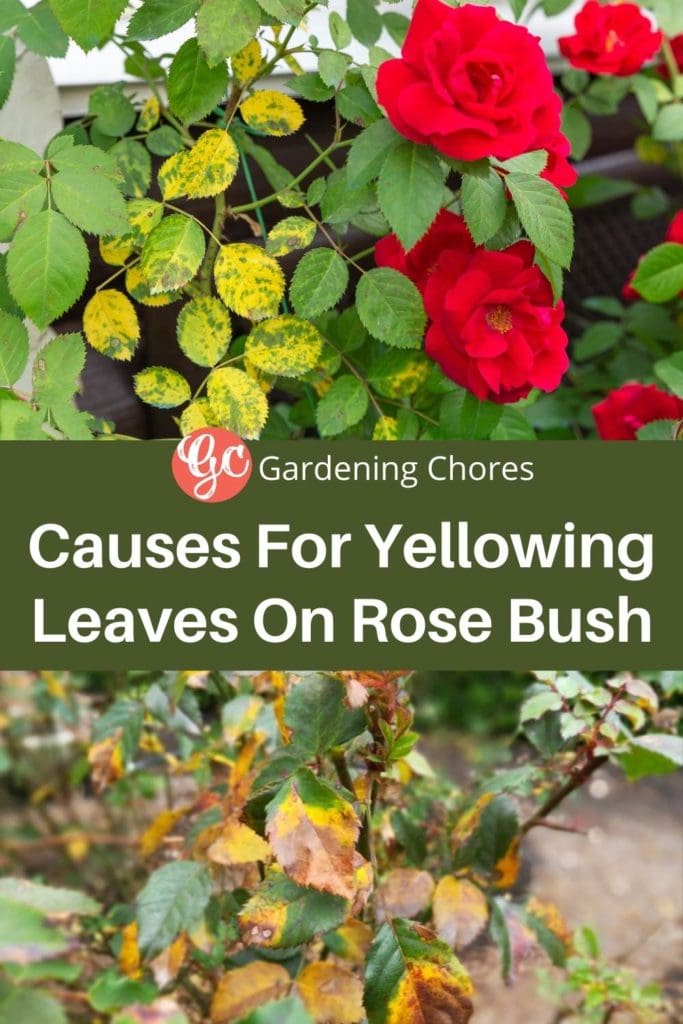

Written By
Maya
Maya is a freelance content writer and avid gardener currently based in Sweden. She gained her BA in Environment and Geography in Canada, which is also where she first learnt about the detriments of the industrialized agricultural system. During the summer she began farming through the WWOOF program, and over the next six years has continued to grow and learn at a number of organic farms and gardens across the US and Canada. She is passionate about the role of regenerative agriculture in wildlife conservation and climate change mitigation, and thinks growing your own food is a key part of revolutionizing the system. In her free time she likes to read, garden, and pet nice dogs.

Your article is very educational. Thank you!
Thank you. Your advice is very helpful. I probably over watering or over fertilizing my roses. I water my roses every other day. I live in Southern California and my roses are planted in pots. I thought by removing the plates that are attached to the bottom of the pots, will help in proper drainage. I never try checking the wetness of the soil and will do that now.
hi, your article is very insightful. Thanks
Thank you! This was the only place with information about yellowing leaves that wasn’t only about black spot. It most likely is magnesium deficiency or spider mites. I just thought it was just a regular tiny white spider.
It’s been raining a lot here in Atlanta, as it usually does in July. I have a rose growing in a container on my balcony and the rains have stopped two days ago. I noticed some yellow leaves and the soil is still very wet
Should I transplant it to a better draining container?
I used the black mulch on my roses and it’s been extremely hot. I’m going to remove the black mulch or at least move away from roots!
Thanks
Willis,Texas
Could a combination of factors like to much rose fertilizer and heat be turning the leaves yellow. How can I fix it. I have one plant with yellow leaves and one that is just wilting.
Thanks. You have been very helpful but please when watering with drip irrigation, how high or low speed must you set the water flow and how many minutes must you time it for. Must it be 15 minutes or 30 minutes.
Article was very helpful, especially liked the homemade remedies for the problems